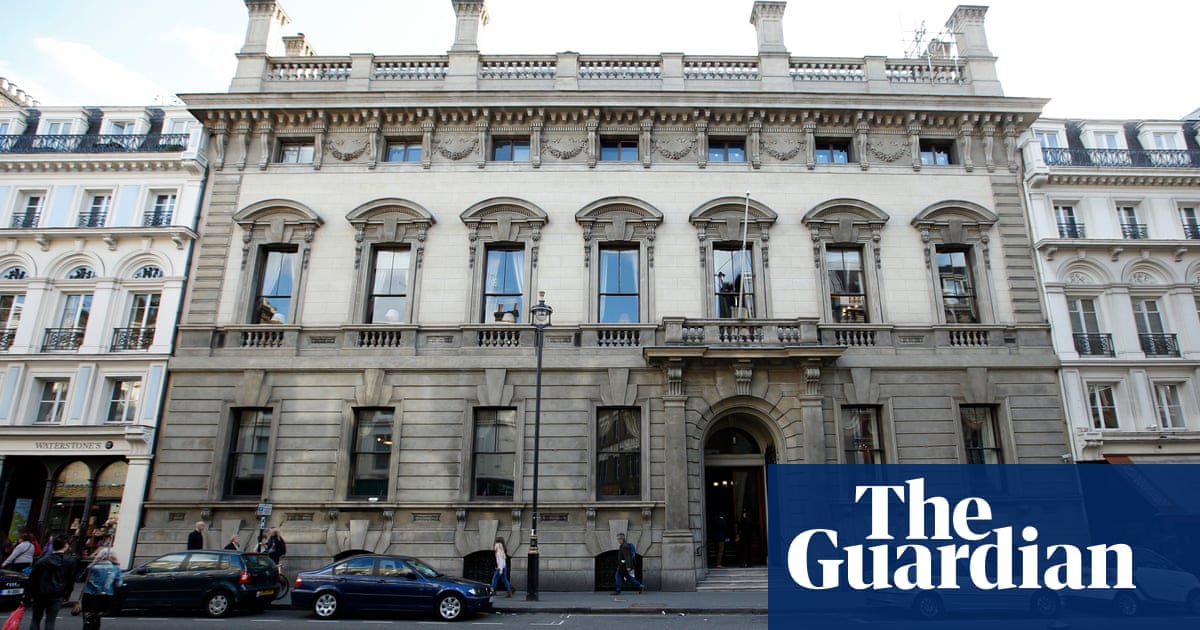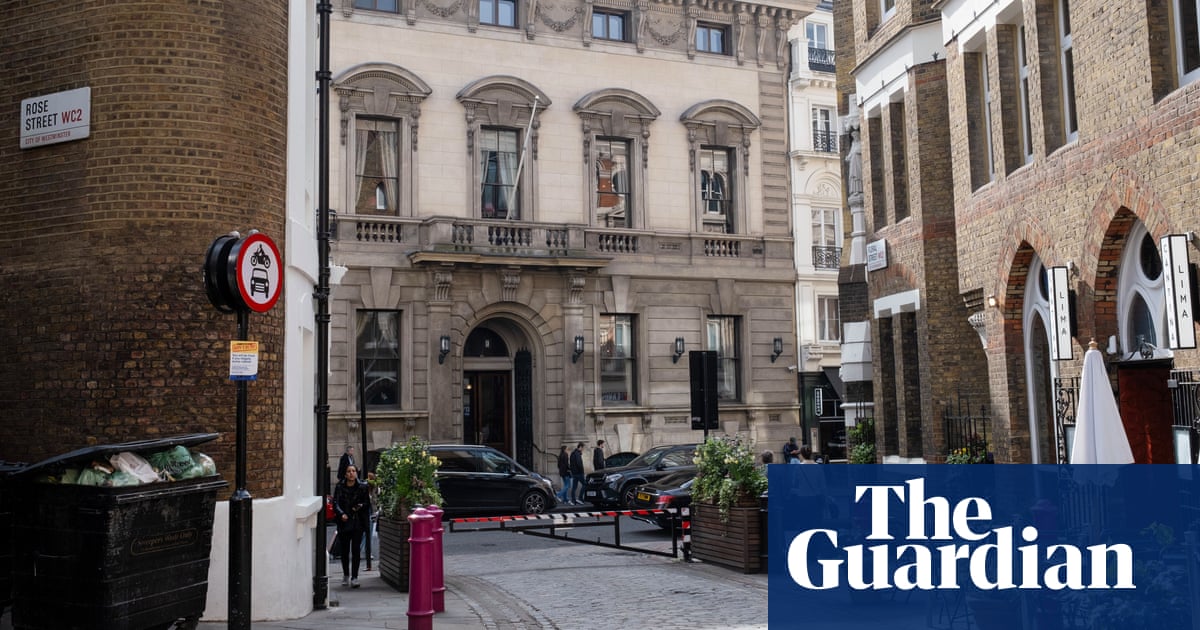
Around the turn of this century, a change to Garrick Club rules finally granted female guests permission to walk up and down the vast, oil painting-lined staircase that leads up from the grand entrance hall to the bars and libraries on the first floor.
However, most women invited to the club will still find they are immediately ushered on arrival by the hall porter towards a side door and a smaller, narrower staircase to hang up their coats upstairs.
The Equality Act 2010 meant the club could no longer prohibit women from sitting at its main 30-seat central table, but it remains extremely rare for a female guest to be invited to eat there. Most of the time they will be seated at a table on the edge of the dining room and handed a menu that gives no indication of prices; club rules state guests (and therefore women) are not “permitted to pay for anything whatsoever”.
After lunch, some members will retreat to sit in leather armchairs beneath the main staircase, an area that remains strictly out of bounds for women.
Attempts to modernise the Garrick are fiercely resisted by many within the club. Members have repeatedly voted down motions proposing that women should be allowed to join, the last time in 2015.
But the club’s position on women does not seem to have made it any less attractive to a string of the most senior figures in the government, Whitehall, the arts and the law.
Simon Case, the head of the civil service, joined the Garrick in 2019, the same year that Oliver Dowden, the deputy prime minister, became a member. Richard Moore, the head of MI6, joined in 2016.
The Garrick is often viewed as a harmless, benign curiosity, a final, lonely slice of an England that forgot to modernise, its never-ending squabbles over female members offering an amusing peepshow into Britain’s declining patriarchal elite as it utters its final gasps.
The Guardian has been publishing articles about the battle to admit women to the Garrick since at least 1966. These death throes of a male-dominated establishment have been dragging on for decades.
It suits members, defensive about accusations of misogyny, to portray the club as a peculiar daycare centre for distinguished but retired figures, people who no longer operate any levers of power.
This characterisation is not reflected in the powerful names drawn from the club’s membership list and now revealed by the Guardian.
While there are fewer politicians in the club than 20 years ago, the Garrick remains an important centre for the legal establishment and Whitehall leaders, and a quiet networking venue for leading figures in the arts.
The club’s 50-page membership book, seen by the Guardian, casts a light on the disproportionately male upper reaches of the British establishment.
Many of the senior judges have Who’s Who entries revealing they have trodden the same narrow path through boarding school, Oxbridge and the bar before arriving at the Garrick.
Flick through the membership list and it is striking how clearly the names reflect a pre-immigration Britain. None of the surnames would have troubled a prep school master calling out the form register in the 1950s.
Does it matter who is allowed to become a member of this relatively small, mostly white, elite club?
Critics say it does if you are a senior civil servant or politician with policy responsibilities or at the top of an arts institution that is struggling to improve its record on accessibility and diversity.
“On days like International Women’s Day, these men spout their support for women having an equal shout, and then they turn out to belong to all-male clubs – that seems a bit weird and hypocritical to me,” said the writer and political journalist Mary Ann Sieghart.
Jemima Olchawski, the chief executive of the feminist campaigning organisation the Fawcett Society, responded with incredulity to the list of senior figures who are club members.
“You can only come in if a man gives you permission? What place is there for that in the 21st century? We talk about the establishment as an old boys’ club and this is literally a club for boys. Because these clubs have existed historically and because powerful people continue to be members of them, it almost makes it seem as if it’s normal to have this kind of discrimination. It isn’t acceptable.”
When they went through the lengthy and complex joining procedure, politicians, civil servants and leaders of cultural establishments will almost certainly have paused to ask themselves: “Do I want to join a club that does not admit women?”
And all of them will have decided: “Yes.”
Olchawski was puzzled by that thought process. “Why would you not want women there? What would having women there do that would be so harmful to the purposes of the club? You’ve got to look at what is the motivation for keeping women out? I can’t see anything other than sexism and misogyny at the root of that.”
Critics of the Garrick are not concerned with stopping men from gathering in single-sex groups (at clubs, pubs or at sports matches), but in highlighting how much senior establishment power is still concentrated in a space that remains closed to women (and which is just as unwelcoming to other groups underrepresented in the top layers of power, because of race and class background).
Olchawski said: “All these senior professionals know that there is a problem where women, and in particular women of colour, are systematically disadvantaged and underrepresented. Theoretically the organisations they work for are committed to challenging that. So to have senior influential people still indulging in the mechanisms that we know keep that system in place, does feel at best careless and at worst arrogant.”
Members often respond defensively to the suggestion that women should be allowed to join. They start by suggesting this is a private matter, adding that it is also a trivial issue, unworthy of column inches; they stress that work is never discussed in the club, so it would be wrong to think that anything as vulgar as networking takes place; and finally they suggest women can join their own single-sex clubs, sometimes proposing the Women’s Institute as a good starting point.
Sieghart said: “The argument that always annoys me is men saying: ‘If women want to have clubs they can start their own clubs.’ But they won’t have the deputy prime minister and the cabinet secretary in them because the British establishment remains so overwhelmingly male.”
The former justice secretary Robert Buckland, who joined in 2019, told the Guardian the Garrick was a place to go “to socialise, to relax and to talk about nice things”, and not a place where work was discussed.
“Private members’ clubs should not be places where undue influence is obtained. They certainly should not be places where matters of public administration or important issues that affect national life should be determined,” he said.
The Garrick’s rulebook prohibits using the club for work, “which includes discussing business matters”, but other members concede work is often conducted there.
A member of another central London club, asking not to be named, said: “People talk about these rules about not doing business in the club, but everybody does business in them all the time – it’s just that it’s good form to not be blatant about it.”
The club remains a useful venue for discreet occasions. The then prime minister Boris Johnson flew back by private jet from the Cop26 climate change conference to attend a dinner at the Garrick for a reunion of Telegraph journalists in 2021.
A senior female KC, who has been a barrister for 30 years, said politicians and judges needed to acknowledge the subtle power of networking that had always taken place on golf courses and in clubs.
She felt male KCs who socialised with judges gained a clear advantage, even if work was never directly discussed.
“I think the thing that makes me the angriest is there’s so much talk about diversity and equality, but institutions like the Garrick just put another hurdle in front of women,” she said, asking not to be named because she did not feel able to criticise judges.
“When you’re an advocate in front of a judge, so much of what happens depends on the trust between the judge and the advocate. If you happen to know each other socially then of course that’s going to make a difference.”
She was profoundly depressed by the club’s continued popularity with many of the country’s most senior lawyers. She said even if the Garrick were to change its rules on female members, few women would be able to find time for clubs. “Many senior male KCs still have wives who take care of the children. I’m through with the years of juggling childcare and homework, and I’ve moved on to caring for an elderly parent. There’s never time to network.”
Sieghart said her early career had been damaged by work quietly done at the club: “My rivals on other papers were schmoozing politicians at the Garrick and getting great stories and gossip out of them. I couldn’t do it simply because I had the wrong anatomy. It was both irritating and detrimental for my career.”
Many within the club say they are actively campaigning for women to be allowed to join. Mention of these campaigns prompts weary eye-rolling from some women, who note that the efforts have been languidly rolling on since the 1970s; in the meantime the club’s pro-women activists have continued enjoying themselves in the club’s bars. Progress has been glacial.
“Don’t keep on saying that you’re doing your best and then remain supporting something which is actively anti-progress,” the theatre director Jude Kelly said.
The club can choose to nominate heads of diplomatic missions to become members while they are posted to London. This invitation will not have been extended to the current French ambassador to the UK, Hélène Duchêne.
For the past few months, arguments about women have started to create a sour atmosphere inside the club. In February, the retired theatre producer Colin Brough, a member for 40 years, was expelled for “conduct unbecoming of a gentleman” after he sent a series of angry emails to members expressing his belief that women should be admitted immediately, and accusing the club’s management of dishonesty and “Putin-style” tactics in the way a poll on the subject was handled.
The club said Brough was not expelled because of his position on women, but because of his accusations towards committee members.
Tensions are occasionally perceptible in the bar where Garrick members gather before lunch. “If you suggest that women should become members, the bar descends on you. It has become very belligerent and unpleasant. The people who are pro-women don’t really talk about it; the anti-women people are talking about it all the time,” someone who joined the club in the 1980s, and who would like the club to admit female members, said. He asked not to be named; unwritten club protocol dictates that club business should not be discussed with outsiders.
“There are some people who don’t want the club to change, and there are some people who just want to be able to get away from the women in their lives,” he added.
During previous discussions on women’s membership of the club, one member said he would vote against, saying the presence of women would threaten the sense of “camaraderie” and “banter” because men “behave differently” around women. He added: “At the moment, any sort of pomposity or self-importance is punctured. You don’t need to show off, you can be yourself.”
Members pay about £1,600 annually for access to the building on Garrick Street, at the heart of London’s theatre district, with its billiard rooms, reading rooms and private and communal dining rooms.
The club’s bars offer a peaceful escape from the crowds of nearby Leicester Square. Roast beef is wheeled around the dining room, kept warm on a platter with a gleaming silver lid. Napkins come in starched linen with “The Garrick” embroidered in red thread, and a stitched buttonhole to help men attach them to the front of their shirts.
The use of mobile phones is restricted and a 10-member wine committee takes great care in maintaining the quality of the cellars. “Intoxicating liquors may be served between 7am and 1am, but between 7am and 10am only in conjunction with food,” the rules state. Although few women attend at lunchtime, there are often a few more in the evening – “wives, girlfriends and no doubt mistresses”, a member said.
Anthony Lejeune, in his 1979 book The Gentlemen’s Clubs of London, wrote: “A good club should be a refuge from the vulgarity of the outside world, a reassuringly fixed point, the echo of a more civilised way of living, a place where (as was once said of an Oxford college) people still prefer a silver salt cellar which doesn’t pour to a plastic one which does.
“A club is a place where a man goes to be among his own kind.”
The financial pressures involved with maintaining vast, draughty properties have nudged many other Pall Mall gentlemen’s clubs to boost their revenues by allowing women to join, but the Garrick has no such difficulties. AA Milne left a quarter of the royalties from his children’s books to his club in 1956; in 2001, Disney bought out the club’s share of the rights for about £60m.
Some people have deleted references to the club in their biographical entries. Simon Case joined in 2019 but stopped mentioning it in his Who’s Who biography some time after 2021.
Others are proud. When interrupted by his fellow Conservative MP Simon Hoare during a debate on the NHS, Jacob Rees-Mogg graciously agreed to “give way to my fellow Garrick member”.
In a 2021 Lords debate, paying tribute to the Duke of Edinburgh days after his death, the eminent fertility doctor Robert Winston, a Garrick member, told fellow peers: “His royal highness was completely at home in the Garrick.”












